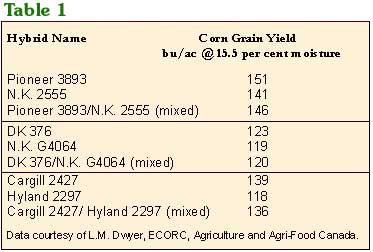
Corn Hybrid
Mixing
Recent headlines and discussions have
pondered mixing seed from two different corn hybrids to increase yield. The
idea of blending seeds from different varieties or hybrids has been around
for quite some time. The theory is that two hybrids planted together in the
same field might be able to produce a yield superior to what the varieties
would produce on their own. This theory is based on two main ideas; first
is that two hybrids may use the resources of light, fertility or water in
patterns that complement each other. Another way of understanding this concept
is to imagine the possibility that two plants from different hybrids are less
competitive with each other than two plants from the same hybrid. The second
idea and the one being advanced most recently is based on the potential to
stimulate hybrid vigour in the seed of a commercial corn crop. When the pollen
of hybrid A pollinates the ear of hybrid B there is the potential for this
vigour to cause kernel size to be greater than if hybrid B received its own
pollen. Several key studies will shed some light on the practicality of these
ideas.
Guelph Work
Corn hybrid blending was
examined in 1978 and 1979 in work done at the University of Guelph by Gary
Hoekstra (now at Kemptville College, University of Guelph). He examined a
number of different corn hybrids under different populations, while blending
the hybrids in mixtures of various proportion. His experiments focused particularly
on the competition effects between hybrids in trying to arrive at mixtures
that would use the available resources more efficiently. The results from
Hoeskstra’s research showed hybrid mixtures never outyielded the highest
yielding hybrid used in the mixture when it was planted in a pure stand.
Minnesota
Trials
The work that has gained
the most attention on this issue lately comes from Minnesota, from Dr. Mark
Westgate (currently at Iowa State University). He focused on the effects that
hybrid mixing (and the resultant cross pollinating) could have on seed size
and grain yield. This study compared hybrid mixing on a large number of on-farm
sites in 1997. Farm co-operators were asked to set up trials comparing two
hybrids planted in an every-other-row pattern. The yields obtained from this
mixed planting were then compared to yields from neighbouring plots where
hybrids A and B were planted in pure stands. They reported about a four-bushel
average gain in yield from mixing hybrids as long as the hybrids were from
different seed companies; when hybrids came from the same company there was
no yield advantage to the mixture. This suggests the cross-pollinating boost
to seed size or yield is greater from two hybrids that have different parentage
and that this would be more likely when hybrids came from different companies.
It should be pointed out, however, that all seed companies do not exclusively
use their own parent material, so a grower would have no way of knowing whether
the parentage of hybrid A from one company could indeed be similar (or dissimilar)
to hybrid B he selected from another company. Dr. Lori Carrigan, Pioneer Hi-Bred
Ltd. has suggested another of the key reasons mixtures generally don’t
yield more is that 50-75 per cent of the pollen that an ear receives is from
its own tassel, eliminating any cross pollinating boost to seed size.
1998 in Ottawa
This past season Dr. Lianne
Dwyer of Agriculture and Agri-food Canada in Ottawa set out to compare three
different sets of corn hybrid mixtures. The hybrid pairs were selected based
on having similar maturities and similar yield potentials. Unlike the work
in Minnesota these hybrids were physically mixed together in equal portions
before being placed into the planter unit hopper. One would have expected
this sort of mixing to increase the percentage of cross-pollinating between
hybrids that occurred relative to an alternate row mixture. Table 1 outlines
the corn hybrids and yield results from this study and illustrates that the
hybrid mixtures always produced a yield somewhere intermediate to the low
and high yields obtained from planting the two hybrids in pure stands. Again
there was no evidence to suggest that the mixture could outyield the best
hybrid when planted by itself.

Bottom Line
The evidence to support hybrid
mixing as a practical approach to increasing corn yields is thin. The biggest
negative is that it would take a fair bit of time and work to finally arrive
at the two hybrids that would combine to consistently produce a yield advantage.
The day you arrive at that mixture is the day five new hybrids appear on the
scene with yield potential or quality traits that surpass anything in your
mix.